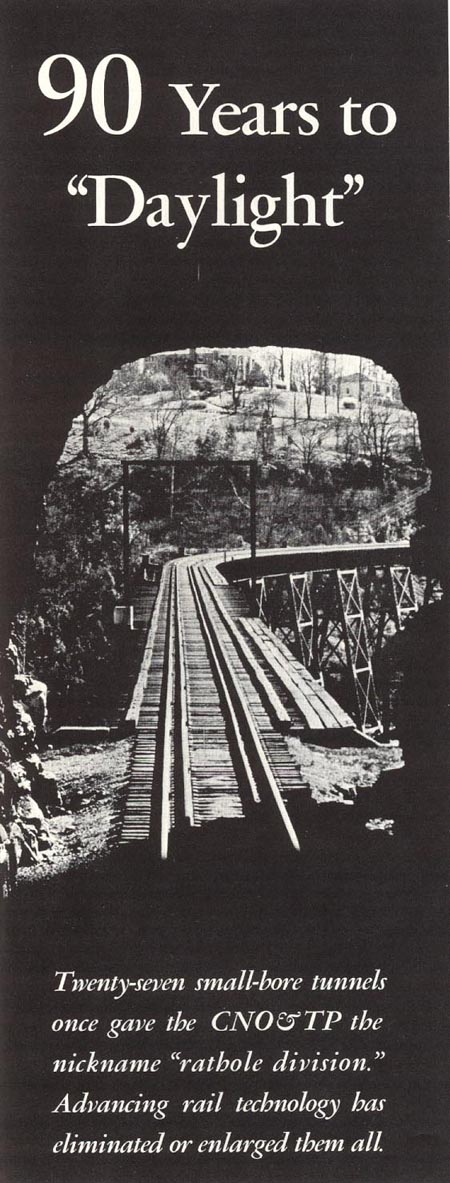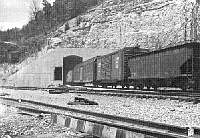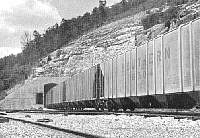
|
When all tunnel clearance restrictions were removed
for all time on The Cincinnati, New Orleans & Texas
Pacific Railway just after midnight on July 10, 1963,
it marked more than the completion of one of the
biggest railroad construction projects in this country
in many years.
It was the culmination of 90 years of tunnel work
on this heavily traveled line and foretold a decent
burial for the old nickname "rathole division."
That nickname once aptly characterized the middle
section of the CNO&TP, where 27 tunnels helped the
line traverse 160 miles of rugged mountain country
between Wilmore, Ky., and Emory Gap, Tenn., and
kept an assortment of civil engineers busy almost from
the day the line opened for traffic.
Southern's 336 mile line from Cincinnati to Chattanooga
was built as the Cincinnati Southern Railway
and, since 1881, has been operated on long term lease
by the CNO&TP, now a member company of Southern
Railway System.
When the City of Cincinnati built the line during
the 1870's the construction, appropriately enough,
began and ended at tunnels.
The first construction contract called for the excavation
of Kings Mountain Tunnel (tunnel No.2) and
the first shovelful of earth was turned at the south end
of that tunnel on December 23, 1873.
Six years later on December 10, 1879 the completed
rails met within a few feet of the center of tunnel
No.15 between New River and Robbins, Tenn.
Tunnels were numbered 1 through 27 (running
from north to south). They ranged in length from
3,992 feet (tunnel No.2) to 189 feet (tunnel No.6).
Trains traveled underground for five miles through
these 27 tunnels.
Tunnel openings were designed to be approximately
15* feet wide and 20 feet high at the top of the arch.
Some of the arches appeared almost round, some resembled
flat topped triangles, others were more jagged
in appearance. The blasting techniques of the 1870's
left something to be desired.
According to the terms of the operating lease, the
CNO&TP was required to do "the arching, with brick
or stone, of the tunnels now lined with timber, or
untimbered tunnels which require arching."
Some of the tunnels had been bored through solid
limestone or sandstone and would never need lining.
Tunnels in softer formations of rock, clay and shale
were for the most part lined with heavy timbers for
temporary protection but were intended to be relined
with masonry. Even 12 inch by 12 inch timber supports
and 3 inch and 6 inch thick planking would soon
deteriorate in the tunnel dampness.
|
The CNO&TP's engineering department went ahead
with the tunnel lining required by the lease as rapidly
as circumstances and finances permitted. (Even at the
prices of those days, this was expensive work.)
By the end of 1884, two tunnels had been completely
lined with brick and stone and five others had
partly finished interiors a total of almost 4,500 feet.
The next eight years, saw supporting masonry installed
in another 11,000 feet of tuneling. By the time tunnel
work came to a temporary halt in early 1893 (the
CNO&TP went into receivership) all or part of 16
tunnels had arches and sidewalls of brick and stone.
After the CNO&TP became allied with the new
Southern Railway Company near the turn of the century,
the last of the tunnel arching required by the
lease moved rapidly to completion and progress began
to catch up with the tunnels on the "rathole division."
Four tunnels remained to be arched, but the engineers
decided to get rid of two of them permanently
instead. Tunnel No.6, the line's shortest at 189 feet,
was "daylighted" into an open cut in 1901. A masonry
lining proved impractical for tunnel No.27 (1,941
feet long and cut through clay, boulders, limestone
and shale) so a new line to bypass the tunnel was
completed in 1902 and placed in service in 1904.
Lining of the two remaining tunnels (in 1902) completed
all the tunnel masonry required by the lease.
Two more short tunnels were eliminated in 1907.
Tunnel No.10 ( 270 feet) was "daylighted" into an
open cut and tunnel No.19 ( 360 feet) was bypassed
by a line change. Four down and 23 to go.
Double tracking of parts of the Cincinnati
Chattanooga line in 1919 and 1920 led to the first wholesale
elimination of tunnels. On the completion of 17 1/2
miles of double track through the mountains of
Tennessee in the fall of 1920, six more tunnels were bypassed
Nos. 13, 14, 17, 18, 20, and 21, a total of
3,180 feet. Now only 17 of the original tunnels
remained and one of those ( No.16 ) carried southbound
traffic only.
Trains thundered through the tunnels for almost a
decade before the next abandonment about 1930. This
was tunnel No.1 and it too was bypassed as a result of
installing double track, this time near Wilmore, Ky.
Two more tunnels were crossed off the list in 1950.
Tunnels 3 and 4 were two of the six tunnels originally
driven through solid rock, never lined with either
timber or masonry. The rugged south portal of tunnel
No.4 presented probably the best known tunnel face
on the entire line. It opened onto the old Cumberland
River bridge.

One of Southern's "Big Boy" boxcars clears the high, wide
portal of a new tunnel. .. and there's lots of room to spare.
|

A string of grain-carrying "Big Johns" rolls south from the
same CNO&TP tunnel on this new, better-service railroad.
|
When the federal government planned Wolf Creek
Dam on the Cumberland River in Kentucky in the
late 1940's it was apparent that the high water level in
the new reservoir would be some 20 feet above the
rails on Southern's existing bridge. Unless the railway
planned to swap its diesels for submarines, a new and
higher bridge was in order.
In constructing the new bridge, the builders
relocated the line to bring it to the north bank of the
Cumberland River through an 82 foot deep cut in
solid rock. As a result, when the new line went into
service on August 3, 1950, tunnels 3 and 4 were
permanently abandoned.
Tunnel No.16 near Huffman, Tenn. on a line that
carried only southbound traffic for years and finally
was reduced to the status of passing siding was
permanently abandoned in 1955 at the time Centralized
Traffic Control was being installed on that section of
the CNO&TP.
As the 1950's drew to a close, only 13 of the original
tunnels remained . . . but these saddled increasing
restrictions on modern railroad operation.
Tunnel openings that had seemed so roomy in 1881
applied an unwelcome clearance "squeeze" to the big,
high capacity cars and high, wide loads that were
helping create savings for shippers and greater traffic
volume for the railroad the freight on which jobs
depend. Even one small bore tunnel was too many on
the busy CNO&TP. The bottleneck to progress
couldn't be allowed to last longer.
In 1961 work began on the abandonment or enlarging
of all the remaining tunnels on the line. Eighteen
months and $32 million later, the "rathole division"
had lost its old nickname for good.
Nine tunnels were bypassed outright by line changes
- Nos. 2, 5, 7, 8, 9, 11, 12, 15 and 23. Three of the
former tunnels (Nos. 22, 24 and 26) were bypassed
through new tunnels, but these have openings twice
as large as the old 20 feet wide and 30 feet high at
the top of the arch. Tunnel No.25, the one remaining
relic of the original tunnel work on the CNO&TP, has
been enlarged to the same generous dimensions.
During construction of almost 25 miles of new rail
line to bypass the tunnels, grades were reduced and
curves flattened to smooth the way for our trains.
Most of all, the track is clear for the heaviest traffic
and biggest loads Southern can foresee.


